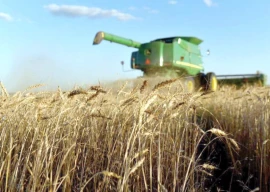
With per capita annual consumption of 125 kg, vis-a-vis global average of 68 kg, wheat fulfills 72% of Pakistanis’ daily caloric needs. Thus, its sustained supply is integral to the country’s food security.
Pakistan’s pride in being an agricultural country, having the world’s largest irrigation system and famous five rivers automatically generates a feeling of food security. However, Pakistan’s ranking at 80, with an overall score of 52.3, by the Global Food Security Index suffices to give us a reality check with Finland topping the list with a score of 85.3 and China and Russia at 24 and 29 places respectively with corresponding scores of 73.7 and 69.3, despite their severe challenges.
A brief journey to the past reveals that by 1976, Pakistan had imported $1.8 billion of agricultural products under PL-480 (Public Law 480). The programme entitled buyers to purchase wheat from the US at concessionary terms.
Pakistan’s annual wheat imports stood at 1.3 million tons by 1960. Though through high-yielding Mexican varieties, Pakistan observed a major upsurge of 48% in production in 1967-68, the imports continued in varying degrees.
While from 1980 to 2000, area under wheat cultivation increased from 6.98 to 8.46 million hectares, production rose from 11.47 to over 21 million tons, yield grew from 1,643 kg to 2,491 kg per hectare, we still imported wheat for 16 of these 20 years.
The current cultivated area for wheat is 9.18 million hectares, which contributes 27.2 million tons this year. There appear to be hardly any expansion margins left in the area, while the demand (currently at 26 million tons) is projected to reach 31.5 million tons in 2025 and above 34 million tons by 2030.
According to the FAO, while Pakistan’s wheat yield in 2019 was 2.8 tons per hectare, for India, Bangladesh and China it was 3.53 tons, 3.07 tons and 5.62 tons respectively. Pakistan’s yield has mostly hovered at 2.7 to 2.8 tons over the last 15 years. Thus, the real margins lie in the yield.
Major challenges
Due to lack of modern grain storage silos and adequate capacity, at least 14% of the grain production in Punjab alone is wasted. Studies estimate these losses to be even higher for the country.
Pakistan has less than 6 million tons of storage capacity. Thus, large quantities end up getting exposed to rains, rats, etc and consequently wasted due to improper storage.
Lack of storage on the farm compels the farmers to make distress selling. This is one of the driving factors for the nuisance value wielded by the middlemen in the pertaining value chain. Also, with its current water availability of 1,000 cubic metres per person per year, Pakistan is already a severely water-stressed country. The main source of water for tillage is the canal irrigation system. About 60% of it goes to waste due to leakage, seepage and poor irrigation practices.
The overriding challenge is the antediluvian structure of land ownership. More than 60% of the households in the rural part of Pakistan are completely landless.
As to the farms, those less than an acre and five acres each constitute 19% and 64% respectively of the total number, though, correspondingly, covering only 1% and 19% of the total area. Thus, leaving aside the landless, even the small farmers remain severely handicapped with high production costs, low yields and negligible access to formal channels of credit. History reveals that what fundamentally ails Pakistan’s agriculture is the pending conclusion of long overdue land reforms. History shows that the awareness caused by polarisation over the note of dissent of Masood Khadarposh had resulted in a major political movement for land reforms in the early years of Pakistan.
This note on the Hari Committee report of 1948 is an important part of history. The committee was constituted in 1946 with the ostensible purpose of identifying the major travails of Sindh’s peasants and recommending solutions to them.
While the report recommended only cosmetic measures, Masood, a public servant and one of the committee members, recommended a package of major land reforms vide a separate note to it. While the movement was suppressed in the western part, the mostly urban middle class, the leadership of the then East Pakistan enacted the East Bengal Land Acquisition and Tenancy Act 1950. It abolished the big estates and fixed the upper ceiling of 30 acres per family.
This struck a deep wedge between the leaderships of the two parts, which later served as a catalyst in the ultimate parting of ways in 1971.
Neighbours
While India’s population grew by four times since 1947, its wheat production increased by 16 times (103.59 million tons in 2019). Similarly, China’s grain production (133.6 million tons in 2019) increased by 9.4 times since 1961 with only a 2.1 times increase in population.
In comparison, though Pakistan’s population almost doubled in the last 30 years, the wheat production increased only by 72%.
What is to be done?
Pakistan needs to target rapid increment of yield and population control. Also, to avoid water wastage and manage its shortage, the canals should be lined with concomitant introduction of water conservation technologies.
This would need a network of skills-based training schools in modern methods of farming and focused efforts along research and development (R&D).
Similarly, the much-criticised role of middlemen would continue till adequate storages are available to the farmers and they are economically empowered. The shortest route to that empowerment lies in land reforms. The reforms should include, besides fixation of ceiling on ownership and distribution of freed-up land among the landless, protection of rights of the tenants and appropriate remuneration for farm labour.
In addition, carefully regulated, corporate farming can help in radicalising agriculture in terms of modernisation, skills base, R&D, yields, etc. Also, the time-tested method of cooperative farming provides a ready solution to the large percentage of small farmers.
In a cooperative, members generally pool their land and other resources. This allows them access to formal credit lines and economies of scale over the entire value chain. It is the fastest route to wealth creation and prosperity for the farmers.
Once empowered, they can send their own representatives to parliament and be the real masters of their destiny. Agricultural cooperatives of various combinations are a global norm. In the EU alone, they had a turnover of 237 billion euros in 2019.
Thus, no long-term “tabdeeli” with respect to food security is possible without tapping the real potential of rural Pakistan, which can only be achieved with the above steps including the fulfillment of unfinished agenda of Masood Khadarposh.
The writer is a petroleum engineer and an oil and gas management professional
Published in The Express Tribune, June 28th, 2021.
Like Business on Facebook, follow @TribuneBiz on Twitter to stay informed and join in the conversation.






















COMMENTS
Comments are moderated and generally will be posted if they are on-topic and not abusive.
For more information, please see our Comments FAQ